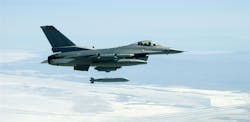Navy asks Raytheon to upgrade data package and software in JSOW smart munitions for allied military forces
PATUXENT RIVER NAS, Md. – Precision munitions experts at Raytheon Technologies Corp. will upgrade hard-target-penetrating and data-linked medium-range precision-guided smart munitions for the governments of Taiwan, Bahrain, and Canada under terms of a $29.4 million contract announced Monday.
Officials of the U.S. Naval Air Systems Command at Patuxent River Naval Air Station, Md., are asking the Raytheon Missiles & Defense segment in Tucson, Ariz., to upgrade the technical data package and software for the AGM-154C Block III Joint Standoff Weapon (JSOW) munition for these allied nations.
The AGM-154 JSOW is medium range precision-guided glide bomb for attacking defended targets from outside the range of standard anti-aircraft defenses. Pilots typically fire JSOW from ranges of 22 to 70 nautical miles. The JSOW Block III adds a Link-16 weapon data link and moving maritime target capability to the AGM-154C.
The weapon can launch from F/A-18, F-16, F-15, F-35, and Jas Gripen jet fighter-bombers; as well as from B-1B, B-2A, and B-52H long-range jet bombers. The AGM-154C JSOW unitary variant uses an imaging infrared seeker with autonomous guidance.
The two-stage AGM-154C carries the BROACH warhead made up from a WDU-44 shaped augmenting warhead and a WDU-45 follow through bomb, and is designed to attack hardened targets like armor, concrete, and earth to enable a large following warhead to explode inside the target. The JSOW is 13 feet long and weighs about 1,000 pounds.
On this systems upgrade contract Raytheon will do the work in Tucson, Ariz.; Goleta, Calif.; McAlester, Okla.; and other U.S. locations, and should be finished by July 2025. For more information contact Raytheon Missiles & Defense online at www.raytheonmissilesanddefense.com, or Naval Air Systems Command at www.navair.navy.mil.

John Keller | Editor-in-Chief
John Keller is the Editor-in-Chief, Military & Aerospace Electronics Magazine--provides extensive coverage and analysis of enabling electronics and optoelectronic technologies in military, space and commercial aviation applications. John has been a member of the Military & Aerospace Electronics staff since 1989 and chief editor since 1995.

